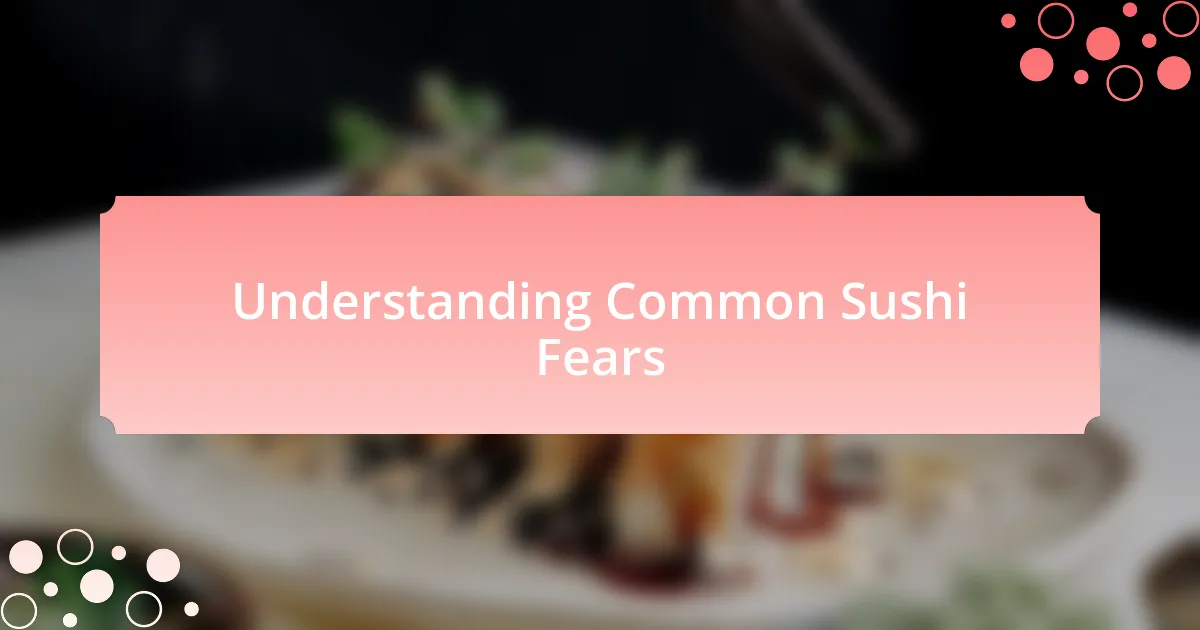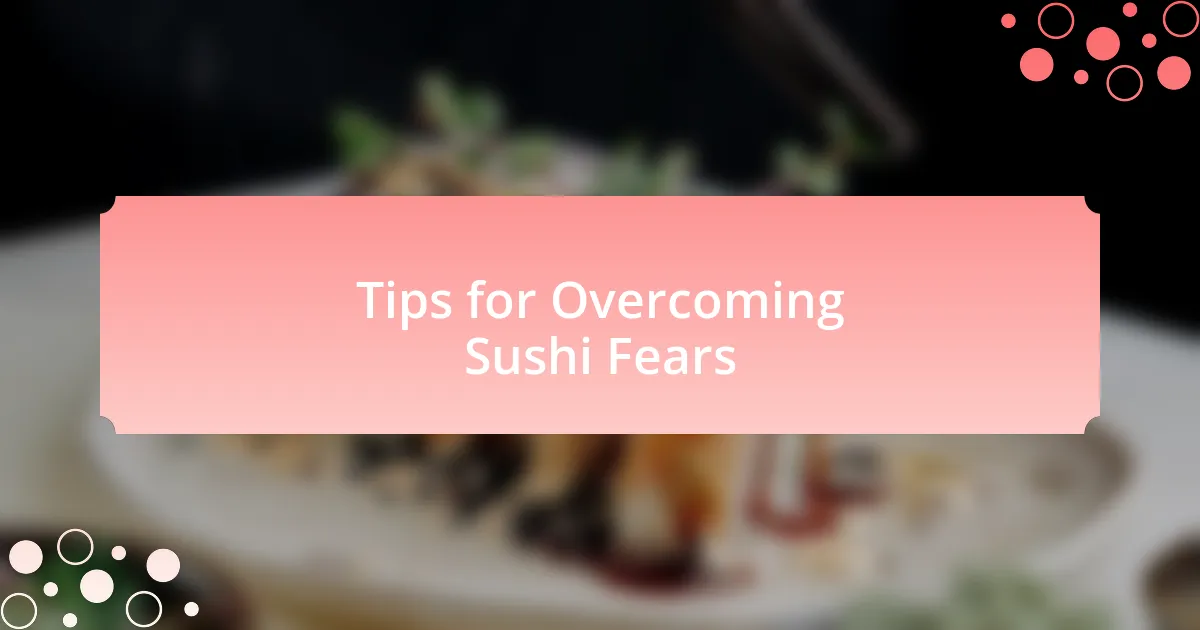Key takeaways:
- Sushi making is a blend of technique, creativity, and personal expression, transforming ingredients into a culinary adventure.
- Common fears include concerns about raw fish safety and mastering the rolling technique; education and practice help overcome these challenges.
- Essential tools like a bamboo mat, sharp knife, and rice cooker enhance the sushi-making experience, making it more enjoyable and less daunting.
- Embracing imperfections and engaging with supportive communities fosters growth and makes the sushi-making journey more rewarding.

Introduction to Sushi Making
Diving into sushi making can be both exciting and intimidating. I remember the first time I stood in front of a bamboo mat, feeling a mix of curiosity and apprehension. What would it be like to transform simple ingredients into something beautiful and delicious?
Sushi making is an art form that combines technique, creativity, and a hint of adventure. When I finally decided to give it a try, I felt like I was embarking on a culinary journey. It wasn’t just about rolling rice and fish; it was about understanding each ingredient and how they come together to create harmony.
What I’ve learned is that making sushi at home allows for countless variations and personal touches. Have you ever considered how empowering it is to craft a dish that reflects your taste? The first few attempts might be clumsy, but with each roll, I discovered not just how to make sushi, but also how to overcome my fears of imperfection in the kitchen.

Understanding Common Sushi Fears
When I first thought about making sushi, the fear of raw fish loomed large in my mind. I remember feeling anxious about the freshness and safety of the ingredients, wondering if I could really trust myself to choose the right fish. It was in those moments of doubt that I realized education is key—understanding how to select high-quality seafood completely transformed my approach.
Another common fear revolves around the technique itself. Picture this: I was convinced I’d never master the delicate art of rolling sushi without making a mess. However, after a few practice sessions, I learned that it’s not as complicated as it seems. With patience and a willingness to break a few rules, I found a rhythm that worked for me, which made the process feel less intimidating and more like a creative exploration.
Lastly, the fear of failure can be paralyzing. I distinctly remember my first attempt when the rolls fell apart, leaving me feeling defeated. But rather than giving up, I embraced those mishaps as valuable lessons. Each imperfect roll taught me more about balance, flavor combinations, and my own resilience, ultimately making my sushi-making journey feel like a celebration of growth rather than pressure to perform perfectly. Have you ever felt that way about learning something new? It’s all part of the experience.

Essential Sushi Making Tools
Having the right tools is crucial for sushi making. I discovered that investing in a good quality bamboo mat was a game changer. The first time I tried rolling without one, I struggled to keep everything together. With the mat, everything felt more organized, allowing me to focus on the flavors rather than wrestling with seaweed and fillings.
Another tool that significantly eased my sushi-making journey was a sharp knife. I remember my initial struggles with a dull blade—slicing through fish felt cumbersome and inefficient. Once I upgraded to a sushi knife, the process became smoother, and I could achieve those beautiful, clean cuts that are essential for presenting sushi. There’s something incredibly satisfying about the precision a sharp knife offers, wouldn’t you agree?
Don’t underestimate the importance of a sushi rice cooker either. When I first made sushi, I was nervous, worried I wouldn’t get the rice perfect. But once I got a rice cooker, all my fears melted away. It cooked the rice consistently every time, leaving me free to focus on perfecting my rolls and experimenting with different ingredients. Having these tools makes sushi making feel less like an insurmountable task and more like an enjoyable culinary adventure.

Basic Sushi Techniques Explained
Mastering the art of sushi making begins with perfecting the rice. I vividly remember the first time I tried to prepare sushi rice; I was overwhelmed by the different steps. It’s not just boiling rice; the key is to wash it until the water runs clear, allowing that starch to come off. After I started using the correct washing technique, my rice achieved the perfect sticky consistency, transforming my sushi from a flop to something I was proud of.
Rolling sushi can feel daunting at first. I know because my initial attempts often ended with fillings spilling out and uneven rolls. I learned that the secret lies in the pressure you apply while rolling. With gentle yet firm pressure, the ingredients blend beautifully, creating a cohesive roll. Have you ever felt that rush of excitement when the roll comes out perfectly? It’s that small win that fuels the passion to keep practicing.
Then there’s the art of slicing your sushi. I remember the first time I attempted it without understanding the angle; it was a disaster! After some trial and error, I discovered that cutting with a smooth, single motion—not sawing back and forth—results in those Instagram-worthy pieces. There’s a certain joy in serving beautifully sliced sushi that invites anticipation for that first bite. Isn’t it fascinating how these little techniques can elevate your sushi experience?

My Personal Journey with Sushi
My journey with sushi truly began when I decided to confront my fear of trying to make it myself. I remember feeling a mix of excitement and dread as I donned my apron for the first time, imagining all the ways I could mess up. The first roll I attempted ended with my hands covered in rice and a very sad-looking creation that barely resembled sushi. But each misstep became a lesson, not just in technique but in perseverance. Have you ever faced a challenge that seemed insurmountable, only to find joy in the struggle itself?
As I progressed, I found that sushi making isn’t just about the ingredients; it’s about the experience. One evening, after a long day, I decided to prepare sushi as a calming ritual. The repetitive motions—slicing, rolling, and arranging—became therapeutic. In that moment, I lost myself in the process, letting go of my day’s stress. It was eye-opening to realize how this tradition, steeped in culture, could also offer personal solace. Have you ever tried cooking something that turned into a meditative escape?
Reflecting on my evolution, I can’t overlook the transformative impact sushi has had on my social life. I remember hosting my first sushi night, inviting friends over with my homemade creations. The nervous energy I felt was replaced with delight as I watched their faces light up with each bite. Sharing those rolls, crafted with my own hands, turned into a celebration of connection and joy. Isn’t it remarkable how food not only nourishes but builds bridges among us?

Tips for Overcoming Sushi Fears
When I first started making sushi, I found it helpful to break the process down into manageable steps. Instead of overwhelming myself with the notion of perfection, I focused on one aspect at a time. For instance, I dedicated a whole evening just to mastering the art of cooking rice. This not only built my confidence but also made me appreciate how each component contributes to the final dish. Have you ever considered that sometimes, less focus on the end result can lead to genuine mastery?
Another tip that really shifted my perspective involved embracing imperfections. I vividly recall the first time I tried to roll sushi. The result looked more like a deconstructed salad than anything else. Instead of getting frustrated, I laughed it off and shared the “creation” on social media. To my surprise, friends found it relatable and encouraging. Who would have thought that showing vulnerability could turn what felt like a disaster into a moment of laughter and connection?
Lastly, I discovered that surrounding myself with supportive people greatly eased my sushi-making fears. I organized a casual sushi-making workshop with a few friends. Not only did we swap tips, but we also encouraged each other along the way. This collaborative environment transformed what once felt like a solitary challenge into a fun, shared experience. Doesn’t it feel empowering to tackle fears in the company of others who are on similar journeys?